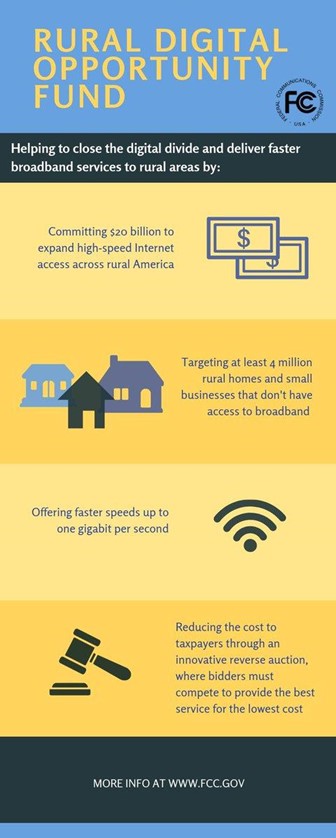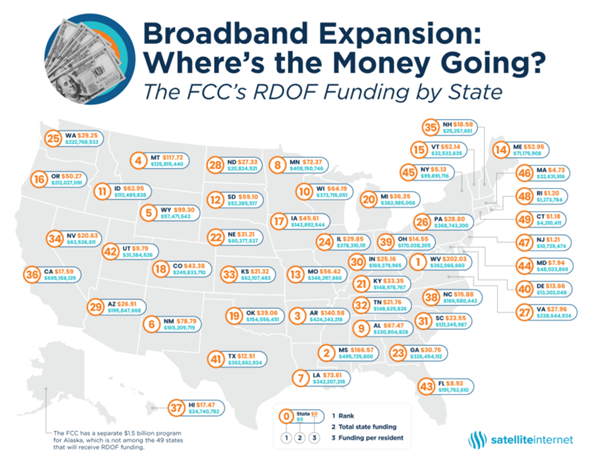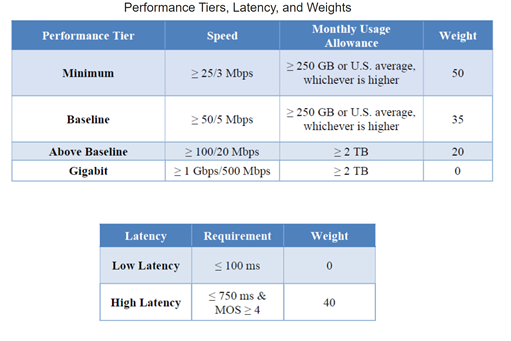
Given that the US is home to modern communication technology and digital media giants, it is difficult to ignore the existing digital divide in the country. Even today, approximately 21 million Americans lack access to adequate broadband for rural areas. With COVID-19 exacerbating the need for rampant digital and connectivity transformation to empower businesses, education, healthcare, and livelihoods of tomorrow, this digital divide can no longer be an elephant in the room.
Enter the US$20.4 billion Rural Digital Opportunity Fund (RDOF) – a once-in-a-lifetime opportunity to erase the divide and transform the lives of millions of Americans with fast broadband access in rural areas. But what exactly is RDOF and how has it become a hot topic of discussion in global ICT and broadband planning circles?
In this blog, we will briefly cover all the major details of the Rural Digital Opportunity Fund, including:
– What is RDOF?
– How does RDOF work?
– What are the different phases of RDOF?
– What is FCC’s auction process for RDOF?
– What obligations do the RDOF-winning bidders have?
Contents
What is RDOF?

The FCC Rural Digital Opportunity Fund is a program designed to ignite the transformation of rural America and its unserved areas with high-speed, reliable and accessible rural broadband services. Through the program, FCC seeks to finance the communication service and internet providers with US$20.4 billion and empower them to deploy Utility Grade Broadband for rural areas across a 10-year period. As far as statistics go, CSPs stand to benefit from the largest distribution of funds from the Universal Service Fund (USF) they have ever received.
RDOF has devised a framework that incorporates a two-phase, competitive reverse auction to authorise and award the bidders with funds. So, who are the service providers eligible for bidding? Everyone from telephone companies, electric cooperatives, and fixed wireless internet providers to cable and satellite operators are welcome to bid.
The goal of the entire process is to deploy networks of tomorrow and provide access to the internet in rural areas. These modern networks will be equipped with higher speeds and lower latency – the perfect solution to meet the needs of the rapid digital transformation, Industry 4.0 era and beyond. The opportunity that RDOF brings will not only allow rural communities in America to scale and grow but will also prove to be a catalyst for the US economy.
On the back of RDOF-financed rural broadband planning, rural communities will thrive at work and play, carriers and utilities will be able to expand their footprint, and the government will be able to take the most fundamental step towards building a smarter, safer and a better society.
An opportunity of a lifetime, indeed.
How does RDOF work?
That the RDOF broadband program grants considerable funding to winning bidders is a given. But how does the entire process work in order to ensure that Utility Grade Broadband to rural areas becomes a possibility?
- Auction – The FCC RDOF has been planned to disburse the US$20.4 billion funds in a two-phase auction. The Phase 1 auction was conducted in 2020, where winning bidders were eligible to start deployment at unserved locations lacking a minimum of 25/3 Mbps broadband. The Phase 2 auction will commence after exhaustive broadband mapping is completed by the FCC. It will target any locations missed out in Phase 1 deployment and any partially-served census blocks.
- Authorization – After winning the RDOF bid, participants must file the FCC Form 683 application. Additionally, they must apply to FCC or relevant states for an eligible telecommunications carrier (ETC) designation. They must also provide details of technology used, the network system design as well as a Project Funding Description. If the application is approved, FCC publishes a notice named ‘Ready to Authorize’.
- Disbursal – Once the bidder receives authorization, the USAC (Universal Service Administration Company) starts disbursing the payments on a monthly basis. These payments will be disbursed across 10 years.
- Deployment – The winning bidders must then complete the deployment as per their proposal and finish the deployment within 8 years, fulfilling all obligated milestones. In year 6, the FCC will also reassess the locations and the deployment, providing bidders with a revised location count and any changes in the deployment plan. Throughout the deployment phase, bidders are required to file and certify deployment data annually in the High Cost Universal Broadband portal for review.
Phases of RDOF
Phase 1
The first phase auction of the Rural Digital Opportunity Fund is already over. By November 25, 2020, it had awarded uS$9.2 billion in funding to 180 winning bidders. As part of RDOF Phase 1, the deployment is targeting census blocks without any previous adequate broadband service of 25/3 Mbps as per the FCC Form 477. Overall, 5.2 million homes and small businesses in the eligible locations are set to receive ultra-fast rural broadband of a minimum 100 Mbps download speeds and 20 Mbps upload speeds (100/20 Mbps). On a more optimistic note, winning carriers are promising to deliver gigabit-speed services to more than 85% of the eligible areas.

Phase 2
As expected, the remaining US$11.2 billion funding support will be up for grabs in the RDOF Phase 2 auction. But what makes this phase different? Here, the eligible locations will be all the unserved census blocks that were not reached during the previous phase and the partially served census blocks as per FCC’s Digital Opportunity Data Collection (DDOC). The DDOC is remapping the availability of broadband networks at a very granular level. Only once it is complete will the Phase 2 auction gets a go-ahead. Such a step makes the program fool-proof and competent.
As of now, RDOF Phase 2 auction has no scheduled date. According to estimates, it can be expected to begin in the last quarter of 2023.
Understanding the FCC’s Auction process for RDOF
Contrary to regular auctions, the RDOF is disbursing precious funds for broadband planning in unserved areas of America using a descending clock, reverse auction. It is a complex process that requires a lot of nuance and consultation with FCC, regulatory and Utility Grade Broadband professionals.
In the FCC auction process, communication service and internet providers basically bid to deliver high-speed broadband and voice services in eligible areas at the lowest cost. Here is how the process functions:
- Any type of service provider or carrier interested in the bidding must first prove if they have a plan for a sustainable business – either with or without the funding from RDOF.
- Once that is established, interested bidders are then required to submit a short form application to the FCC. This is done to gain approval for bidding in the RDOF auction phase.
- Any bidders must also plan strategically in order to define the best possible bid. Such a proposal takes into account the regions where the bidder is interested in setting up broadband services and the most effective rural broadband network architecture for the same.
- Additionally, bidders must also define optimum construction, deployment and operational costs and take into consideration any regulatory guidelines.
- Finally, interested parties that are accepted to participate in the auction do so by bidding for a specific percentage allocation of the RDOF funding in order to realise their proposal.

What will be the course of action for service providers?
Once the communication service providers are successful in bidding for RDOF, they are obliged to fulfil their vision for bringing rural broadband in accordance with their proposed plans. The obligations include:
- All successful RDOF bidders must provide at least one standalone voice service and one broadband service to all locations which were awarded to them.
- The speeds provided by any such voice service and broadband service must be aligned to the one stated in the winning bid. 25 Mbps downstream and 3 Mbps upstream are the lower limits for any network connections deployed.
- The rate of providing such standalone voice and broadband to rural areas should be reasonable and comparable to similar city-based networks.
- The internet providers must also complete any such deployment over a period of 8 years of the 10-year RDOF program.
These obligations not only secure the outcome of the funding provided and the vision of the RDOF program, but also provide the internet providers with a clear objective. To achieve the same, interim deployment milestones are also in place. Accordingly, all carriers must ensure the following levels of project deployments in a phased manner:
- 40% completion by three years from funding authorisation
- 60% completion by the fourth year
- 80% completion by the fifth year
- 100% completion by the sixth year
But what about the remaining four years? Well, as carriers race to finish 100% deployment by year 6, the FCC will simultaneously revise and publish the new locations and their count at the same time. Thereafter, the service providers get two years – as mentioned in the beginning – to deploy the networks completely to any new locations as per the revised count. Carriers can always seek additional RDOF support or reduction on a pro-rata basis if the additional locations are 35% more than the original or less than 65% of the original locations respectively. Additionally, any carrier with reduced locations must fulfil 100% deployment by the end of year six.
Lastly, in order to report the progress update, service providers should complete certain annual filings and certifications:
- By March 1, provide geolocated broadband deployment data to establish where deployment was carried out in the previous year. The verification is then carried out by the USAC.
- Any failure to reach the milestone deployment should also be notified within 10 business days to the FCC, USAC, and the relevant governments.
- File and certify the Carrier Data Annual Collection Form by July 1.
- Obtain certification that the High Cost funding has been used correctly and in accordance with the RDOF program rules by October 1.
It remains to be seen how the RDOF broadband for all action plan phases out. With optimism high and advancements being made at a steady pace, this could be the decade of transformation that America has been waiting for.
FAQs
What does RDOF stand for?
The term RDOF stands for Rural Digital Opportunity Fund. It is an initiative by the Federal Communications Commission that aims to finance the construction and implementation of high-speed broadband network connectivity in the underserved rural areas of the US. Under RDOF, US$20.4 billion has been earmarked to fund communication service providers to transform the lives of millions in rural America with adequate broadband service, i.e., 25 Mbps downstream and 3 Mbps upstream (25/3).
When is the RDOF auction?
To award funds to various communication service and internet providers, RDOF follows a complex, two-phase, competitive reverse auction process. This framework allows the interested CSPs to bid for a specific percentage of the funds in order to build the requisite networks in one or more eligible areas. So, when is the RDOF auction? So far, Phase I of the RDOF auction has already occurred. It ended on November 25th, 2020 – promising approximately US$9.2 billion from the RDOF funds to 180 winning bidders. On the other hand, there is no scheduled date for the Phase II auction. It will only occur once the new FCC broadband planning map has been created using updated Broadband Data Collection (BDC) progress data. As per estimates, the Phase II auction could thus occur towards the end of 2023.
Which areas and providers are eligible for RDOF funding?
As per the FCC Rural Digital Opportunity Fund, census blocks completely or partially unserved by voice and broadband with minimum download speeds of 25 Mbps are eligible for funding. While the Phase I of the initiative is over, Phase II will cover any partially served areas and locations that were not funded in the first phase. As for service providers, the eligibility criterion dictates that they must offer a minimum of one voice and one broadband service at speeds as per their winning bids in a commercial capacity inside their awarded area – all within 8 years of a 10-year period.













